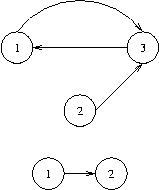POJ 2553 The Bottom of a Graph (Tarjan)
The Bottom of a Graph
| Time Limit: 3000MS | Memory Limit: 65536K | |
| Total Submissions: 11981 | Accepted: 4931 |
Description
We will use the following (standard) definitions from graph theory. Let V be a nonempty and finite set, its elements being called vertices (or nodes). Let E be a subset of the Cartesian product V×V, its elements being called edges. Then G=(V,E) is called a directed graph.
Let n be a positive integer, and let p=(e1,...,en) be a sequence of length n of edges ei∈E such that ei=(vi,vi+1) for a sequence of vertices (v1,...,vn+1). Then p is called a path from vertex v1to vertex vn+1 in G and we say that vn+1 is reachable from v1, writing (v1→vn+1).
Here are some new definitions. A node v in a graph G=(V,E) is called a sink, if for every node w in G that is reachable from v, v is also reachable from w. The bottom of a graph is the subset of all nodes that are sinks, i.e., bottom(G)={v∈V|∀w∈V:(v→w)⇒(w→v)}. You have to calculate the bottom of certain graphs.
Let n be a positive integer, and let p=(e1,...,en) be a sequence of length n of edges ei∈E such that ei=(vi,vi+1) for a sequence of vertices (v1,...,vn+1). Then p is called a path from vertex v1to vertex vn+1 in G and we say that vn+1 is reachable from v1, writing (v1→vn+1).
Here are some new definitions. A node v in a graph G=(V,E) is called a sink, if for every node w in G that is reachable from v, v is also reachable from w. The bottom of a graph is the subset of all nodes that are sinks, i.e., bottom(G)={v∈V|∀w∈V:(v→w)⇒(w→v)}. You have to calculate the bottom of certain graphs.
Input
The input contains several test cases, each of which corresponds to a directed graph G. Each test case starts with an integer number v, denoting the number of vertices of G=(V,E), where the vertices will be identified by the integer numbers in the set V={1,...,v}. You may assume that 1<=v<=5000. That is followed by a non-negative integer e and, thereafter, e pairs of vertex identifiers v1,w1,...,ve,we with the meaning that (vi,wi)∈E. There are no edges other than specified by these pairs. The last test case is followed by a zero.
Output
For each test case output the bottom of the specified graph on a single line. To this end, print the numbers of all nodes that are sinks in sorted order separated by a single space character. If the bottom is empty, print an empty line.

Sample Input
3 3 1 3 2 3 3 1 2 1 1 2 0
Sample Output
1 3 2
思路:
终于过了。。。。
因为模板错误,让我痛不欲生。
这题完成缩点之后,找出没有出度的点就行了。
http://www.cnblogs.com/ZGQblogs/p/9104381.html
我的模板会在此更新,感谢感谢!
我的上一篇博客里面的代码(POJ 1236)的确是错的,这个里面的代码应该就没问题了。。
代码
#include<iostream>
#include<cstdio>
#include<vector>
#include<stack>
#include<cstring>
using namespace std;
int n,m;
int book[50008];
int low[50008],num[50008],cnt=1,index;
int color[50008];
bool flag[50008];
vector<int>u[50008];
stack<int>st;
int sig=0;
void Tarjan(int t)
{
num[t]=low[t]=++index;
st.push(t);
book[t]=true;
int siz=u[t].size();
for(int i=0;i<siz;i++){
if(!num[u[t][i]]){
Tarjan(u[t][i]);
low[t]=min(low[t],low[u[t][i]]);
}
else if(book[u[t][i]]){low[t]=min(low[t],low[u[t][i]]);}
}
if(num[t]==low[t]){
sig++;
while(1){
cnt=st.top();
st.pop();
color[cnt]=sig;
book[cnt]=0;
if(cnt==t){break;}
}
}
}
bool init()
{
scanf("%d",&n);
for(int i=1;i<=n;i++){
u[i].clear();
}
while(!st.empty()){
st.pop();
}
memset(book,0,sizeof(book));
memset(low,0,sizeof(low));
memset(flag,0,sizeof(flag));
memset(color,0,sizeof(color));
memset(num,0,sizeof(num));
index=0;
if(n==0){return false;}
scanf("%d",&m);
int x,y;
for(int i=1;i<=m;i++){
scanf("%d%d",&x,&y);
u[x].push_back(y);
}
return true;
}
void solve()
{
int siz;
int tle=0;
for(int i=1;i<=n;i++){
siz=u[i].size();
for(int j=0;j<siz;j++){
if(color[u[i][j]]!=color[i]){flag[color[i]]=true;}
}
}
for(int i=1;i<=n;i++){
if(!flag[color[i]]){
tle++?printf(" %d",i):printf("%d",i);
}
}
printf("\n");
}
int main()
{
while(init()){
for(int i=1;i<=n;i++){
if(!num[i]){Tarjan(i);cnt++;}
}
solve();
}
}
如需转载,请注明出处
如有侵权,联系删除
2290713181@qq.com
如有侵权,联系删除
2290713181@qq.com



